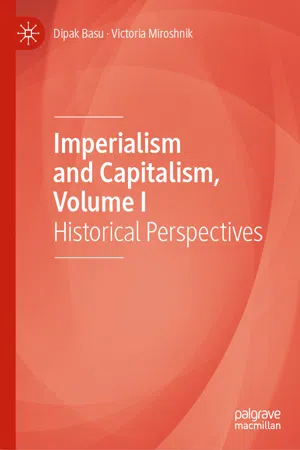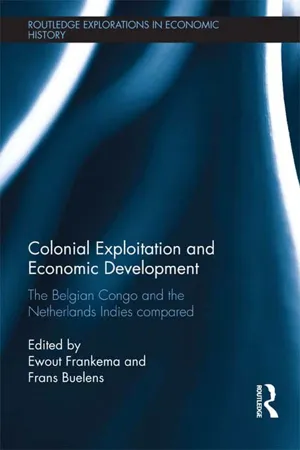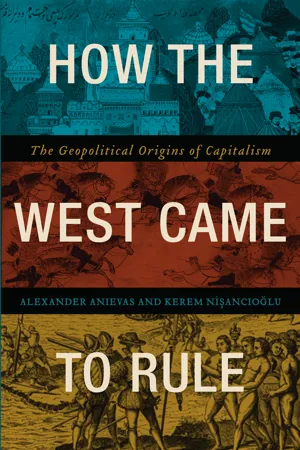History
Dutch Colonization
Dutch colonization refers to the period when the Netherlands established and expanded its overseas territories, particularly in the Americas, Africa, and Asia. This colonization was driven by trade interests, leading to the establishment of trading posts, settlements, and control over valuable resources. The Dutch East India Company played a significant role in this expansion, shaping the economic and political landscape of the regions they colonized.
Written by Perlego with AI-assistance
Related key terms
3 Key excerpts on "Dutch Colonization"
- eBook - ePub
Imperialism and Capitalism, Volume I
Historical Perspectives
- Dipak Basu, Victoria Miroshnik(Authors)
- 2020(Publication Date)
- Palgrave Macmillan(Publisher)
1901 ).In the early years of the seventeenth century, Dutch ships sailed relatively unhindered to Brazil and the Dutch capital was already informally or illegally penetrating the emerging Brazilian sugar industry. Dutch revenues derived from the slave trade and slave plantations represented only a minor part of the national income, although he points out that Dutch participation in the Atlantic slave-based economy may have imparted beneficial effects in terms of employment in the Republic. The Dutch transatlantic slave trade had a much greater impact on the Dutch economy overall than hitherto assumed (Furnivall 1944 ; Bosma 2014 ).From the 1720s until the early nineteenth century , large quantities of coffee were exported from Suriname. These plantations were highly capital intensive and therefore state of the art was ground breaking. This brings us to the debate about the late abolition of slavery in the Dutch colonial empire, which in the Dutch West Indies occurred as late as 1863 (Van Kol 1901 ). In the eighteenth century , Suriname and Dutch Antilles played a far more prominent role in the commodity trade, and that together with the trade in Africa, this would approximate to the value of the trade with Asia at that time. Moreover, apart from the WIC trade in slaves, private Dutch slave trade was extensive until the early nineteenth century . Slave-based profits and participation in both the Asian and Atlantic economies may have encouraged crucial innovations in shipping and insurance.The import and export trade of the Netherlands Indies thrived on credit. It acted as a lubricant for the trading sector and the entire economy. Access to sufficient capital was a precondition for the smooth running of the economic system. - eBook - ePub
- Ewout Frankema, Frans Buelens(Authors)
- 2013(Publication Date)
- Routledge(Publisher)
2 Colonial extraction in the Indonesian archipelago
A long historical view
Thee Kian Wie2.1 Introduction1
This chapter assesses the history of Dutch colonial extraction in the Indonesian archipelago in a long-term perspective. The gradually increasing intensity of Dutch involvement in the indigenous economies and polities since the late sixteenth century highlights one of the key distinctions from the extension of Belgian domination over the Congo, which evolved in a much shorter period of time. The chapter starts with a discussion of the bilateral monopoly that the Dutch East India Company (Vereenigde Oost-indische Compagnie, henceforth VOC) obtained on the spice trade in the Moluccas in the early seventeenth century. The VOC's control of the spice trade took the form of a monopsony on the purchase of spices cultivated by the local population and a monopoly on the sale of these spices in the Dutch Republic. The chapter then addresses the change in extractive institutions during the expansion of state rule under the Netherlands Indies government after the Napoleonic wars, focusing on the development of the infamous Cultivation System (Cultuurstelsel, CS) in Java (1830–70) and the debate concerning the welfare effects of the CS.The chapter then goes on to discuss the abolition of the CS and the liberal reforms introduced in the 1870s, highlighting the emergence of alternative means of colonial extraction in the form of a penal sanction (a specific form of later coercion) imposed on the indentured workers recruited by the plantations in East Sumatra in the second half of the nineteenth century. The Ethical Policy launched by the Netherlands Indies government in the first decade of the twentieth century can be considered as a first attempt to use public policy instruments to raise the welfare of broad layers of the Indonesian population, but it will be argued that this shift in the approach of the Dutch was partial and not sustained. Finally, the chapter briefly delves into the extractive policies imposed by the Japanese military authorities to support Japan's war effort during its occupation of the Netherlands Indies (March 1942 to mid-August 1945), namely forcibly acquiring food and manpower from the Indonesian population. - eBook - ePub
How the West Came to Rule
The Geopolitical Origins of Capitalism
- Alexander Anievas, Kerem Nişancıoğlu(Authors)
- 2015(Publication Date)
- Pluto Press(Publisher)
In the first section, we show that by the turn of the 17th century, the Dutch ruling class was suffering from a crisis in the relatively low supply of the single most important commodity in the capitalist mode of production: labour-power. In the second section, we then examine how the Dutch ruling class, unlike the Venetians and Genoese who preceded them, were able to solve this crisis through the accumulation, subordination and bringing together of a vast amount of capital and labour-power on a global scale. This involved a combination of New World surpluses with coerced labour in Asia. It took place through the historically specific experience of Dutch colonialism as an encounter – a moment of combination – between the Dutch East India Company (VOC) and various Asian societies in the Indian Ocean littoral. We argue that were it not for this moment of combination, and were it not for the Dutch drawing on an extensive – albeit dispersed – mass of labour-power in Asia, Holland’s capitalist development would have been unsustainable in the ways other antediluvian forms were. We then argue in the third section that the emergence of capitalism as a mode of production – as a wider set of practices that enable the reproduction of the capital–wage-labour relation – was necessarily dependent on, and built upon, the exploitation of ‘unfree’ labour. In fact, the vast quantities of unfree or unwaged labour exploited in Asia were the foundations on which the freedom of waged-labour in the Dutch Republic was built.The Specificity and Limits of Dutch CapitalismDutch Institutional InnovationsWhy the Dutch and not the Italian city-states? In his magisterial The Long Twentieth Century, Giovanni Arrighi argues that the Dutch represented a break from not only prior instances of capital, but also the feudal structure of power in Europe more broadly. According to Arrighi, the Dutch were the first to ‘be presented with, and seize, the opportunity to transform the European system of rule to suit the requirements of the accumulation of capital on a world scale’.34 As such, they entered into conflict with feudal powers, and simultaneously came to be seen as champions of new dynastic rulers seeking to break from the hold of the Habsburg Empire and Papacy,35 leading to a broader sociopolitical transformation of the European states system. For Arrighi, this transformation found its clearest expression in the Thirty Years’ War and the subsequent conclusion of hostilities with the 1648 Treaty of Westphalia. The concomitant treaties pertaining to the freedom of the seas (and therefore trade) further indicate the reordering of the European states system in line with the requirements of capital accumulation on an expanded scale of operation. In these ways, Dutch policies aimed at transforming the European geopolitical order in the service of extended capital accumulation over the 17th century represented the kind of ‘hegemonic agency’ (albeit limited and partial) conceived by various neo-Gramscian scholars36
Learn about this page
Index pages curate the most relevant extracts from our library of academic textbooks. They’ve been created using an in-house natural language model (NLM), each adding context and meaning to key research topics.


